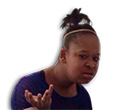knock knees
Genu valgum, commonly called "
knock-knee", is a condition in which the
knees angle in and touch each other when the
legs are straightened. Individuals with severe
valgus deformities are typically unable to touch their feet together while simultaneously straightening the legs. The term originates from the
Latin genu, 'knee', and
valgus which actually means 'bent outwards', but in this case, it is used to describe the
distal portion of the knee joint which bends outwards and thus the
proximal portion seems to be bent inwards. For citation and more information on uses of the words
Valgus and
Varus, please visit the internal link to -
varus.
Mild genu valgum is diagnosed when a person standing upright with the feet touching also shows the knees touching. It can be seen in children from ages 2 to 5, and is often corrected naturally as children grow. However, the condition may continue or worsen with age, particularly when it is the result of a disease, such as
rickets. Idiopathic genu valgum is a form that is either
congenital or has no known cause.
Other systemic conditions may be associated, such as
Schnyder crystalline corneal dystrophy, an autosomal dominant condition frequently reported with
hyperlipidemia.
The degree of genu valgum can clinically be estimated by the Q angle, which is the angle formed by a line drawn from the anterior superior iliac spine through the center of the patella and a line drawn from the center of the patella to the center of the tibial tubercle. In women, the Q angle should be less than 22 degrees with the knee in extension and less than 9 degrees with the knee in 90 degrees of flexion. In men, the Q angle should be less than 18 degrees with the knee in extension and less than 8 degrees with the knee in 90 degrees of flexion. A typical Q angle is 12 degrees for men and 17 degrees for women.[5]
Treatment[edit]
The treatment of genu valgum in children depends on the underlying cause. Developmental also known as idiopathic genu valgum is usually self-limiting and resolves during childhood. Genu valgum secondary to nutritional
rickets is typically treated with life style modifications in the form of adequate sun exposure to ensure receiving the daily requirements of vitamin D and nutrition with rich calcium diet. Additionally calcium and vitamin D supplementations may be used. If the deformity does not resolve despite the above conservative treatment and the deformity is severe and causing gait impairment, then surgery can be an option. Typically, guided growth surgery is used to straighten the deformed bone.
[10] Genu valgum arising from
osteochondrodysplasia[4] usually needs repeated guided growth surgical interventions.
[11] Genu valgum secondary to trauma depends on the degree of physeal damage. And usually limb reconstruction procedures are needed, especially if trauma occurs in the early years of life where the anticipated remaining longitudinal bone growth is great.
The treatment of genu valgum in adults depends on the underlying cause and the degree of joint involvement namely arthritis. Bone corrective osteotomies and prosthetic joint replacement may be used depending upon the patient's age and symptomatology in terms of pain and functional impairment. Weight loss and substitution of high-impact for low-impact exercise can help slow progression of the condition. With every step, the patient's weight places a distortion on the knee toward a knocked knee position, and the effect is increased with increased angle or increased weight. Even in the normal knee position, the
femurs function at an angle because they connect to the hip girdle at points much further apart than they connect at the knees.
Working with a physical medicine specialist such as a
physiatrist, or a
physiotherapist may assist a patient learning how to improve outcomes and use the leg muscles properly to support the bone structures.
Alternative or complementary treatments may include certain procedures from
Iyengar Yoga or the
Feldenkrais Method.










 kenny the Jet be wearing customade outifts and shoes with the knocked knees and beating Chuck to the studio jumbotron for halftime analysis but hes high self esteem and dont givva f*ck about wut people think lol
kenny the Jet be wearing customade outifts and shoes with the knocked knees and beating Chuck to the studio jumbotron for halftime analysis but hes high self esteem and dont givva f*ck about wut people think lol